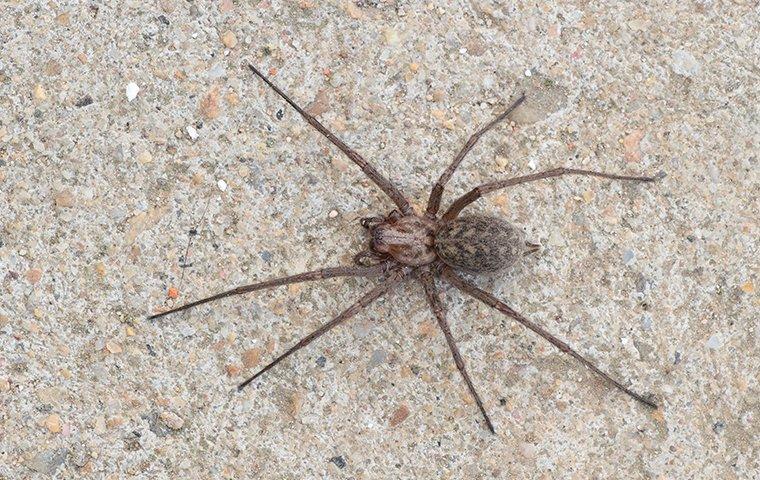
The Trick To Keeping Spiders Out Of Your Mooresville Home
There are hundreds of species of spiders in North Carolina, each one necessary to the health of the ecosystem around us and most almost entirely harmless.
Spiders feed on insects and other spiders, acting as part of nature's pest control and keeping the size of the population of harmful insects down. Without them in your yard, the number of ticks, cockroaches, flies, and mosquitoes would explode out of control.
A couple of spider species, however, while not likely to bite unless no other recourse is left, carry enough venom to cause significant injury to us humans and our four-legged friends.
Being able to differentiate a dangerous spider on your property from a harmless one and knowing how to deal with a spider infestation can mean the difference between a peaceful and beneficial coexistence with them and a visit to an emergency room.
Let's take a quick look at common species of spiders in North Carolina, their habits and behaviors, what you can do to keep spiders out of your home, and, if prevention methods fail, where to find reliable and efficient pest control in Mooresville to kick them out of your house.

Habits And Behaviors Of Common Spiders
North Carolina boasts one of the most diverse ecosystems in the United States, featuring thousands of species of insects and over 700 species of spiders that prey on them. Thankfully, the chances of encountering most of them are pretty slim, with the following Mooresville Spiders being the most likely to find their way into your home:
- House spiders are the most common to invade our homes, measuring between 3/16 and 5/16 of an inch and usually yellowish-brown in color. Their webs are usually found in the upper corners of the room or under furniture and are tangled and irregular in shape. Finding webs in the corners or seeing the spiders themselves are the signs of an infestation to watch for.
- Orb weaver spiders come in a number of different colors, patterns, and varieties, but most of them are 1/2 to 1 inch in size, with colors varying from reddish-brown and grey to bright yellow. They weave large circular webs and spend most of their time in them, waiting for an unfortunate insect to come in contact with the threads and become trapped. Orb weaver spiders are not dangerous, and the best way to spot their presence is to watch for their webs and silken egg sacks.
- Cellar spiders, as the name suggests, prefer environments reminiscent of an old-fashioned dark and damp cellar. They are 1/4 to 3/ 8 of an inch in size with small bodies and long, skinny legs. Cellar spiders are most often pale yellow to grey in color, and you can spot them in the middle of their loose, irregular webs. Cellar spiders are not aggressive and not likely to bite; the best signs of their presence on your property are the webs they weave, silken egg sacks, or the spiders themselves.
- Wolf spiders are some of the most intimidating-looking spider varieties in our state. They grow up to 1 3/8 inches in size with stout bodies and long legs. They are usually dark brown. Wolf spiders are active hunters, capable of moving with surprising speed. They don't weave webs; instead, they chase down their prey. As intimidating as they look, wolf spiders are not dangerous, and while their bite can be quite painful, they are not likely to bite unless handled. Since wolf spiders don't bother weaving webs, the only sign of them on your property is seeing spiders themselves.
- Black widow spiders are one of the most dangerous spiders you're likely to encounter on your property. Females are easily identified by glossy black bodies 1 1/2 to 1 3/8 inches in size and a telltale bright red hourglass marking on the abdomen. Black widow spiders spin irregularly shaped webs that are often found close to the ground and are commonly found hanging in them upside down. Black widow spiders are poisonous and will bite in self-defense. Their venom affects the respiratory and nervous systems and can result in high blood pressure, heart palpitations, fever, and nausea. A black widow bite can be fatal, especially for a child, but the last registered case of death from a black widow spider bite was more than 40 years ago.
- Brown recluse spiders are one of the two venomous spider species in the United States. They are usually 1/4 to 1/2 an inch in size and brown, with six pairs of eyes arranged in a semicircle. The easiest way to identify them is by a violin-shaped mark on their back. Brown recluse spiders are content to stay out of sight and avoid human interaction but will bite if cornered or handled. They carry the most potent venom of any creature in North America but, thankfully, inject an amount that's unlikely to lead to terminal consequences in a human adult. Nonetheless, if bitten by a brown recluse, your best option is to see medical help immediately.
- Yellow sac spiders are on the smaller side, growing between 1/4 and 3/8 of an inch. They're usually light yellow to cream in color and, being nocturnal, are often very hard to spot. Yellow sac spiders don't weave webs but instead construct tube-like retreats to stay hidden during the day and spend their nights hunting for prey. They are not dangerous to humans and sustain themselves on smaller insects. Watch for the spiders themselves or their silken retreats in your house, often hidden in the corners.
Spiders are nocturnal and will do their best to stay off our radars, but eggs in each spider egg sack can number in the hundreds, and a single spider can quickly become a full-blown infestation of nightmarish proportions.
Why You Don't Want Spiders Hanging Around Your Home
Most spiders carry some sort of venom, but since their prey consists of insects, they've evolved to produce and inject just enough venom to debilitate their prey, making them relatively harmless to humans. The two spider species capable of causing serious harm to people include brown recluse and black widow spiders. Thankfully, neither is aggressive. Both species are easy to identify and stay away from.
Regardless of the threat their venom poses, a house infested with spiders is not a place anyone would find comfortable, and decorating your home with spider webs is a good idea only on Halloween.
But the biggest danger of spiders infesting your home is why they suddenly became interested in your house. Spiders have no interest in the food in your pantry or the comforts of your home; they are dedicated predators motivated by one thing — access to prey. Spiders coming into your Mooresville house usually means there is an insect infestation they're interested in hunting.
Five Naturally Effective Spider Prevention Tips
Spiders are experts at staying out of sight and multiply quickly, making a spider infestation one of the hardest to resolve. For a homeowner dealing with spiders on their own, the best chance of successfully handling the situation is to prevent it from occurring in the first place by making your home as unappealing to spiders as possible and restricting their access inside.
The following simple tips will help you get that done:
- Get rid of clutter both inside and outside your home to remove hiding spaces spiders can use.
- Don't store firewood next to your house; spiders, especially brown recluse spiders, love making their homes in firewood stacks.
- Seal cracks and crevices in your home's outside walls and foundation.
- Check your window and door screens and make sure there are no rips that would let a spider through.
- Cover vents and drains with close-nit mesh.
The most important step you can and should take in preventing a spider infestation is to take care of whatever insect infestation is attracting them to your home.
Professional Pest Control Is A Great Spider Control Solution
When researching DIY remedies to control a spider infestation, you'll come across a host of different methods and tactics, most involving essential oils and strong-smelling ingredients like citrus and vinegar.
The thinking here is that if you're using an ingredient that spiders don't want to be around, you'll be able to chase them away from your house. The problem with that approach is twofold; you're not likely to cover the thousands of feet of the perimeter of your home with essential oils, and even if you manage to, their effects will likely be gone come the first rain.
The second problem with this approach is that it only works as a prevention method. By the time you're seeing spiders or other signs of an infestation, they are already inside the walls, and warding them off is not going to accomplish anything.
At Lake Norman Home Services, we've been helping Moorseville residents get rid of spiders and other pests for over 30 years. We have the knowledge, tools, and experience to identify the spider species you're dealing with and can get them off your property without endangering your health or the safety of your loved ones.
If you're dealing with a spider infestation, give us a call today to learn more about our residential and commercial pest control services in Mooresville.


Customer Reviews
-
“Lake Norman pest control does a wonderful job all around and even explained the safety concerns I had of the products for my new baby and dog.”- Lauren G.
-
“Lake Norman Pest Control has always been consistent with their service quality and more than fair with pricing.”- Michael C.
-
“He called me after the appointment and gave me a summary of the service and he made some additional recommendations.”- Leslie Z.
-
Jake promptly arrived and asked what issues we were having and quickly began applying treatment. He was professional and thorough. Very pleased with the service today.- Lisa C.
-
“Jake promptly arrived and asked what issues we were having and quickly began applying treatment.”- Lisa C.
-
“Lake Norman always does a great job in communicating and shows up at their committed times.”- Mike C.
-
“Michael has beHe and every representative we’ve worked with from this company have been very kind and good at listening to our needs. en super helpful! He's prompt, thorough, and responsive to all of our questions.”- Kimberly G.
-
“Our technician, Jake, has been very helpful. He has been on time and responsive to all my questions.”- Laurence P.


Why Choose Lake Norman Home Services?
-
Give A CrapDelight others by owning your role and saying yes. Take pride in how you appear & act & every other detail of the job. Be on time, attentive, & enthusiastic. Act as if the buck stops with you on every aspect of the job.
-
Chase PerfectionChase Perfection, knowing full well we will not reach it, but along the way we will catch excellence. Have a sense of urgency; Go-Forth Time - right now might be the only time you have to get it right.
-
Dig Deeper
Be an action-oriented professional that makes decisions based on evidence rather than stories & assumptions. Stay curious. Data can speak for itself.
Understand the cause of the fire rather than rushing to extinguish it.
-
Fight For SimplicityKeep it simple & consistent. Focus on how things should be done every time.
-
Face It, Fix ItConfront challenges directly and address issues head-on. A bias for action and powerful conversations drive our progress. It’s about getting it right rather than being right.
-
Grow!Growth is our purpose. Growing as people & growing our business.